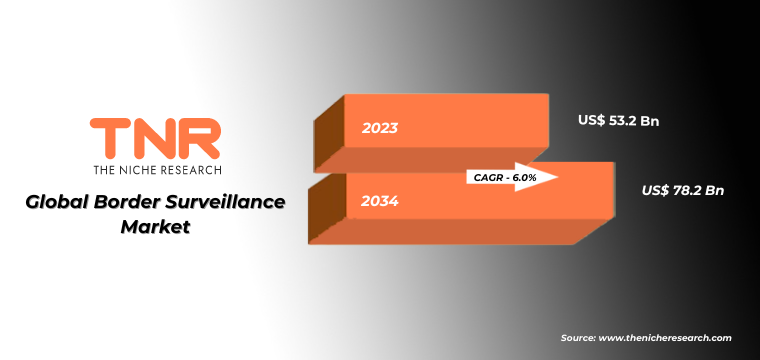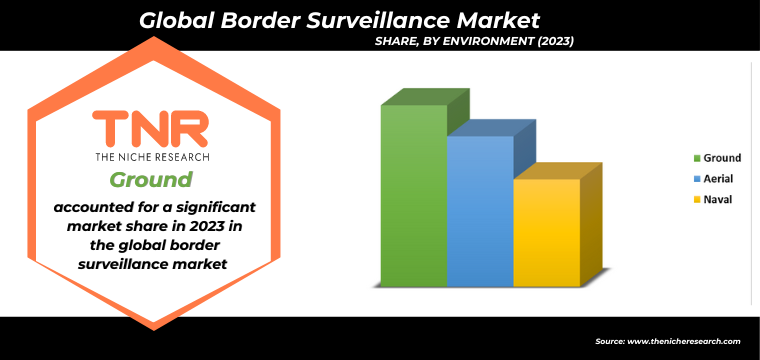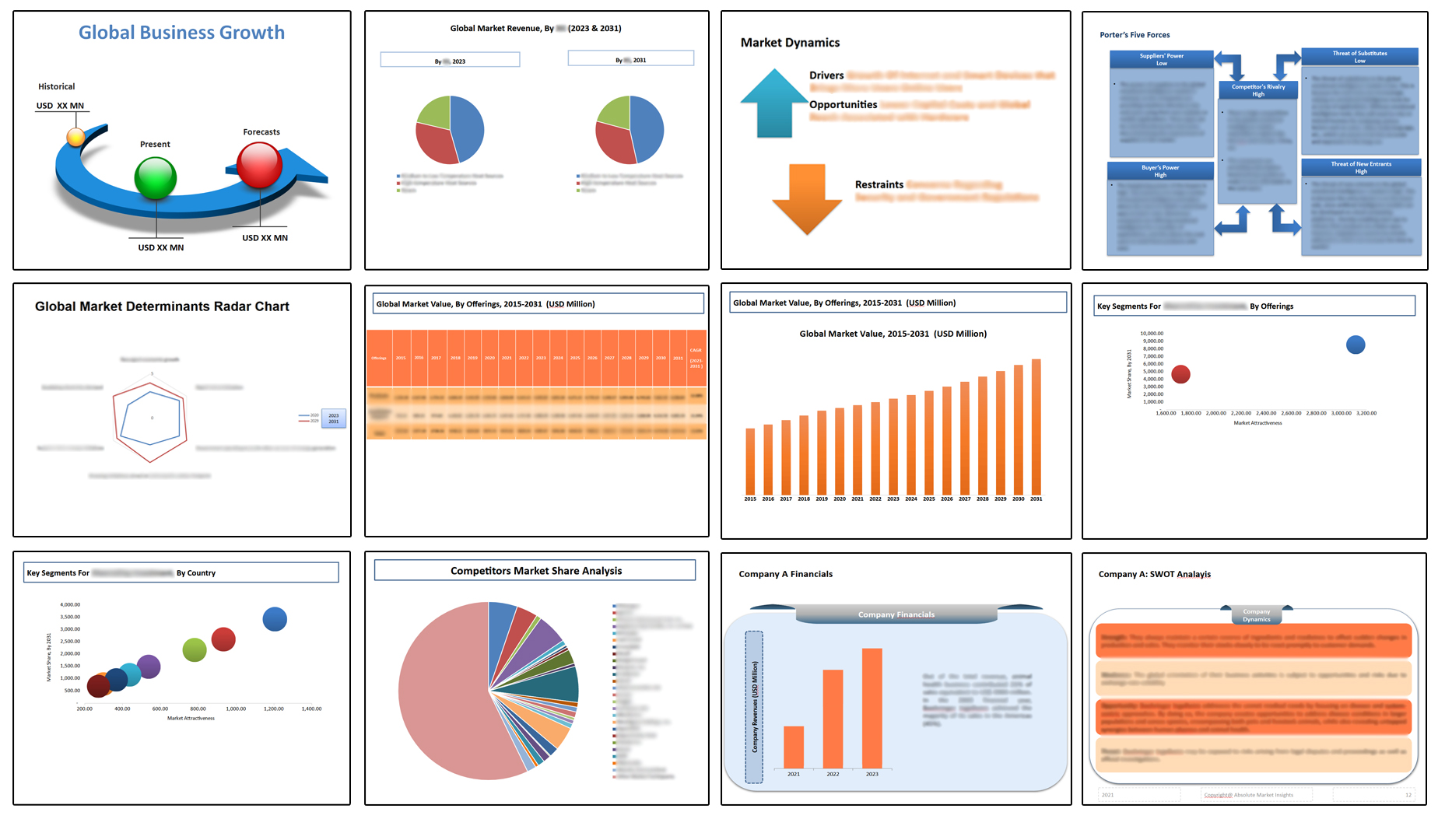Global Border Surveillance Market: By System, By Environment, By Region & Segmental Insights Trends and Forecast, 2024 – 2034
- Industry: Technology
- Report ID: TNR-110-1097
- Number of Pages: 420
- Table/Charts : Yes
- May, 2024
- Base Year : 2024
- No. of Companies : 10+
- No. of Countries : 29
- Views : 10204
- Covid Impact Covered: Yes
- War Impact Covered: Yes
- Formats : PDF, Excel, PPT
Border surveillance involves the monitoring and protection of national borders to prevent illegal activities such as unauthorized crossings, smuggling, and other threats to national security. This surveillance is essential for maintaining national security, managing immigration, and facilitating lawful trade. It uses a variety of advanced technologies and systems to ensure comprehensive coverage and effective monitoring
The global border surveillance market is experiencing significant growth driven by increasing geopolitical tensions, cross-border threats, and advancements in surveillance technology. Increasing political instability and conflicts in various regions have heightened the need for enhanced border security. Nations are investing heavily in advanced surveillance systems to safeguard against illegal immigration, smuggling, and terrorist activities. The persistent threat of terrorism and organized crime necessitates robust border surveillance measures. Advanced surveillance systems help in detecting and preventing potential threats before they infiltrate national borders. The deployment and maintenance of sophisticated surveillance systems require significant investment. High costs can be a barrier, particularly for developing nations with limited budgets.
In terms of revenue, the global border surveillance market was worth US$ 53.2 Bn in 2023, anticipated to witness CAGR of 6.0% During 2024 – 2034.

Global Border Surveillance Market Dynamics
Rising Geopolitical Tensions: Increasing political instability and conflicts in various regions have heightened the need for enhanced border security. Nations are investing heavily in advanced surveillance systems to safeguard against illegal immigration, smuggling, and terrorist activities.
Technological Advancements: Innovations in surveillance technology, such as artificial intelligence, machine learning, and advanced sensor systems, are revolutionizing border security. These technologies enable more efficient and accurate monitoring, detection, and response mechanisms.
Government Initiatives and Funding: Governments worldwide are prioritizing border security, leading to increased budget allocations for surveillance infrastructure. Initiatives like the U.S. Customs and Border Protection’s Integrated Fixed Towers (IFT) and Europe’s Border Surveillance System (EUROSUR) exemplify this trend.
Camera Systems has Garnered Major Market Share in the Global Border Surveillance Market in 2023
Camera systems play a crucial role in modern border surveillance, offering real-time monitoring, high-resolution imagery, and automated threat detection capabilities. These systems include a variety of technologies such as thermal cameras, infrared cameras, and high-definition cameras integrated with advanced analytics. The rise in illegal activities such as human trafficking, drug smuggling, and unauthorized border crossings has heightened the need for robust surveillance systems.
Camera systems provide critical visual intelligence that helps border security agencies monitor and respond to these threats effectively. Continuous innovations in camera technology, including the development of high-definition (HD) and ultra-high-definition (UHD) cameras, thermal imaging, and night vision capabilities, enhance the effectiveness of surveillance systems. The integration of artificial intelligence (AI) and machine learning algorithms allows for real-time data analysis and automated threat detection, making camera systems more efficient and reliable.
Governments worldwide are prioritizing the enhancement of border security through substantial investments in surveillance infrastructure. Programs like the U.S. Customs and Border Protection’s Remote Video Surveillance System (RVSS) and Europe’s Border Surveillance System (EUROSUR) are driving demand for advanced camera systems. These initiatives aim to deploy state-of-the-art surveillance technologies to secure national borders.

By Environment, Ground Segment had the Highest Share in the Global Border Surveillance Market in 2023.
The Ground segment dominated the global Border Surveillance market, in terms of revenue and is estimated to sustain its dominance over the forecast period. Ground-based surveillance systems are integral components of border security, providing critical monitoring and detection capabilities along land borders. Continuous advancements in surveillance technology, such as high-resolution cameras, thermal imaging, and motion sensors, enhance the effectiveness of ground-based surveillance systems.
These technological innovations improve detection capabilities, enabling border security agencies to identify and respond to threats more efficiently. Heightened geopolitical tensions and the proliferation of cross-border threats, including illegal immigration, drug trafficking, and terrorism, drive the demand for robust ground surveillance systems. Governments seek to safeguard national sovereignty and protect citizens from external threats by enhancing border security measures. Government initiatives aimed at strengthening border security drive the demand for ground surveillance systems. Increased budget allocations for border control projects, such as the construction of border barriers and the deployment of surveillance infrastructure, contribute to the growing market demand. For example, programs like the U.S.-Mexico border wall project have led to significant investments in ground surveillance technologies.
North America has garnered major market share in 2023 in the global border surveillance market.
The United States shares extensive land borders with Canada and Mexico, making border security a top priority. Geopolitical factors, including immigration policies, trade relations, and transnational threats, drive the demand for advanced surveillance systems. Heightened security concerns, such as illegal immigration and drug trafficking, contribute to the need for robust border surveillance measures. Government initiatives, such as the U.S. Department of Homeland Security’s (DHS) Border Security Improvement Plan, drive the demand for border surveillance systems in North America.
Increased funding for border security projects, including the construction of barriers and the deployment of surveillance technologies, fuels market growth. Programs like the Secure Border Initiative (SBI) focus on enhancing border monitoring capabilities through the deployment of advanced surveillance systems. North America is a major hub for international trade and commerce, with significant volumes of goods and people crossing borders daily. Effective border surveillance systems are essential for facilitating legitimate trade and travel while preventing illegal activities. The need to secure ports of entry and critical infrastructure drives demand for surveillance technologies that can monitor border crossings and detect unauthorized movements.

Competitive Landscape: Global Border Surveillance Market:
- DJI
- FLIR Systems
- General Atomics
- General Dynamics Corporation
- Honeywell International Inc
- Leonardo Spa
- Lockheed Martin Corporation
- Moog Inc
- Northrop Grumman Corporation
- Thales Group
- Other Industry Participants
Global Border Surveillance Market: Key Data Points
| Report Specifications | Details |
| Market Revenue in 2023 | US$ 53.2 Bn |
| Market Size Forecast by 2034 | US$ 78.2 Bn |
| Growth Rate (CAGR) | 6.0% |
| Historic Data | 2016 – 2022 |
| Base Year for Estimation | 2023 |
| Forecast Period | 2024 – 2034 |
| Report Inclusions | Market Size & Estimates, Market Dynamics, Competitive Scenario, Trends, Growth Factors, Market Determinants, Key Investment Segmentation, Product/Service/Solutions Benchmarking |
| Segments Covered | By System, By Environment |
| Regions Covered | North America, Europe, Asia Pacific, Middle East & Africa, Latin America |
| Countries Covered | U.S., Canada, Mexico, Rest of North America, France, The UK, Spain, Germany, Italy, Nordic Countries (Denmark, Finland, Iceland, Sweden, Norway), Benelux Union (Belgium, The Netherlands, Luxembourg), Rest of Europe, China, Japan, India, New Zealand, Australia, South Korea, Southeast Asia (Indonesia, Thailand, Malaysia, Singapore, Rest of Southeast Asia), Rest of Asia Pacific, Saudi Arabia, UAE, Egypt, Kuwait, South Africa, Rest of Middle East & Africa, Brazil, Argentina, Rest of Latin America |
| Key Players | DJI,FLIR Systems, General Atomics, General Dynamics Corporation, Honeywell International Inc, Leonardo Spa, Lockheed Martin Corporation, Moog Inc, Northrop Grumman Corporation, Thales Group, Other Industry Participants |
| Customization Scope | Customization allows for the inclusion/modification of content pertaining to geographical regions, countries, and specific market segments. |
| Pricing & Procurement Options | Explore purchase options tailored to your specific research requirements |
| Contact Details | Consult With Our Expert
Japan (Toll-Free): +81 663-386-8111 South Korea (Toll-Free): +82-808- 703-126 Saudi Arabia (Toll-Free): +966 800-850-1643 United Kingdom: +44 753-710-5080 United States: +1 302-232-5106 E-mail: askanexpert@thenicheresearch.com |
Global Border Surveillance Market
By System
- Radar Systems
- Laser Systems
- Camera Systems
- IR & Thermal Imaging Cameras
- CCTV
- Perimeter Intrusion Detection Systems
- Electric Fencing Systems
- Laser Fencing Systems
- Unmanned Vehicle
- Unmanned Aerial Vehicle (UAV)
- Unmanned Ground Vehicle (UGV)
- Unmanned Underwater Vehicle (UUV)
- Autonomous Underwater Vehicle (AUV)
- Remotely Operated Underwater Vehicle (ROVS)
- Wide-Band Wireless Communication Systems
- Command and Control Systems
- Display Systems
- Video Distribution Systems
- Audio Systems
- Biometrics Systems
- Others
By Environment
- Ground
- Aerial
- Naval
By Region
- North America (U.S., Canada, Mexico, Rest of North America)
- Europe (France, The UK, Spain, Germany, Italy, Nordic Countries (Denmark, Finland, Iceland, Sweden, Norway), Benelux Union (Belgium, The Netherlands, Luxembourg), Rest of Europe)
- Asia Pacific (China, Japan, India, New Zealand, Australia, South Korea, Southeast Asia (Indonesia, Thailand, Malaysia, Singapore, Rest of Southeast Asia), Rest of Asia Pacific)
- Middle East & Africa (Saudi Arabia, UAE, Egypt, Kuwait, South Africa, Rest of Middle East & Africa)
- Latin America (Brazil, Argentina, Rest of Latin America)
Report Coverage and Layouts

Table of Contents
**Exclusive for Multi-User and Enterprise User.
Global Border Surveillance Market
By System
- Radar Systems
- Laser Systems
- Camera Systems
- IR & Thermal Imaging Cameras
- CCTV
- Perimeter Intrusion Detection Systems
- Electric Fencing Systems
- Laser Fencing Systems
- Unmanned Vehicle
- Unmanned Aerial Vehicle (UAV)
- Unmanned Ground Vehicle (UGV)
- Unmanned Underwater Vehicle (UUV)
- Autonomous Underwater Vehicle (AUV)
- Remotely Operated Underwater Vehicle (ROVS)
- Wide-Band Wireless Communication Systems
- Command and Control Systems
- Display Systems
- Video Distribution Systems
- Audio Systems
- Biometrics Systems
- Others
By Environment
- Ground
- Aerial
- Naval
By Region
- North America (U.S., Canada, Mexico, Rest of North America)
- Europe (France, The UK, Spain, Germany, Italy, Nordic Countries (Denmark, Finland, Iceland, Sweden, Norway), Benelux Union (Belgium, The Netherlands, Luxembourg), Rest of Europe)
- Asia Pacific (China, Japan, India, New Zealand, Australia, South Korea, Southeast Asia (Indonesia, Thailand, Malaysia, Singapore, Rest of Southeast Asia), Rest of Asia Pacific)
- Middle East & Africa (Saudi Arabia, UAE, Egypt, Kuwait, South Africa, Rest of Middle East & Africa)
- Latin America (Brazil, Argentina, Rest of Latin America)
The Niche Research approach encompasses both primary and secondary research methods to provide comprehensive insights. While primary research is the cornerstone of our studies, we also incorporate secondary research sources such as company annual reports, premium industry databases, press releases, industry journals, and white papers.
Within our primary research, we actively engage with various industry stakeholders, conducting paid interviews and surveys. Our meticulous analysis extends to every market participant in major countries, allowing us to thoroughly examine their portfolios, calculate market shares, and segment revenues.
Our data collection primarily focuses on individual countries within our research scope, enabling us to estimate regional market sizes. Typically, we employ a bottom-up approach, meticulously tracking trends in different countries. We analyze growth drivers, constraints, technological innovations, and opportunities for each country, ultimately arriving at regional figures.Our process begins by examining the growth prospects of each country. Building upon these insights, we project growth and trends for the entire region. Finally, we utilize our proprietary model to refine estimations and forecasts.
Our data validation standards are integral to ensuring the reliability and accuracy of our research findings. Here’s a breakdown of our data validation processes and the stakeholders we engage with during our primary research:
- Supply Side Analysis: We initiate a supply side analysis by directly contacting market participants, through telephonic interviews and questionnaires containing both open-ended and close-ended questions. We gather information on their portfolios, segment revenues, developments, and growth strategies.
- Demand Side Analysis: To gain insights into adoption trends and consumer preferences, we reach out to target customers and users (non-vendors). This information forms a vital part of the qualitative analysis section of our reports, covering market dynamics, adoption trends, consumer behavior, spending patterns, and other related aspects.
- Consultant Insights: We tap into the expertise of our partner consultants from around the world to obtain their unique viewpoints and perspectives. Their insights contribute to a well-rounded understanding of the markets under investigation.
- In-House Validation: To ensure data accuracy and reliability, we conduct cross-validation of data points and information through our in-house team of consultants and utilize advanced data modeling tools for thorough verification.
The forecasts we provide are based on a comprehensive assessment of various factors, including:
- Market Trends and Past Performance (Last Five Years): We accurately analyze market trends and performance data from preceding five years to identify historical patterns and understand the market’s evolution.
- Historical Performance and Growth of Market Participants: We assess the historical performance and growth trajectories of key market participants. This analysis provides insights into the competitive landscape and individual company strategies.
- Market Determinants Impact Analysis (Next Eight Years): We conduct a rigorous analysis of the factors that are projected to influence the market over the next eight years. This includes assessing both internal and external determinants that can shape market dynamics.
- Drivers and Challenges for the Forecast Period:Identify the factors expected to drive market growth during the forecast period, as well as the challenges that the industry may face. This analysis aids in deriving an accurate growth rate projection.
- New Acquisitions, Collaborations, or Partnerships: We keep a close watch on any new acquisitions, collaborations, or partnerships within the industry. These developments can have a significant impact on market dynamics and competitiveness.
- Macro and Micro Factors Analysis:A thorough examination of both macro-level factors (e.g., economic trends, regulatory changes) and micro-level factors (e.g., technological advancements, consumer preferences) that may influence the market during the forecast period.
- End-User Sentiment Analysis: To understand the market from the end-user perspective, we conduct sentiment analysis. This involves assessing the sentiment, preferences, and feedback of the end-users, which can provide valuable insights into market trends.
- Perspective of Primary Participants: Insights gathered directly from primary research participants play a crucial role in shaping our forecasts. Their perspectives and experiences provide valuable qualitative data.
- Year-on-Year Growth Trend: We utilize a year-on-year growth trend based on historical market growth and expected future trends. This helps in formulating our growth projections, aligning them with the market’s historical performance.
Research process adopted by TNR involves multiple stages, including data collection, validation, quality checks, and presentation. It’s crucial that the data and information we provide add value to your existing market understanding and expertise. We have also established partnerships with business consulting, research, and survey organizations across regions and globally to collaborate on regional analysis and data validation, ensuring the highest level of accuracy and reliability in our reports.









